Grow A Scented Patio
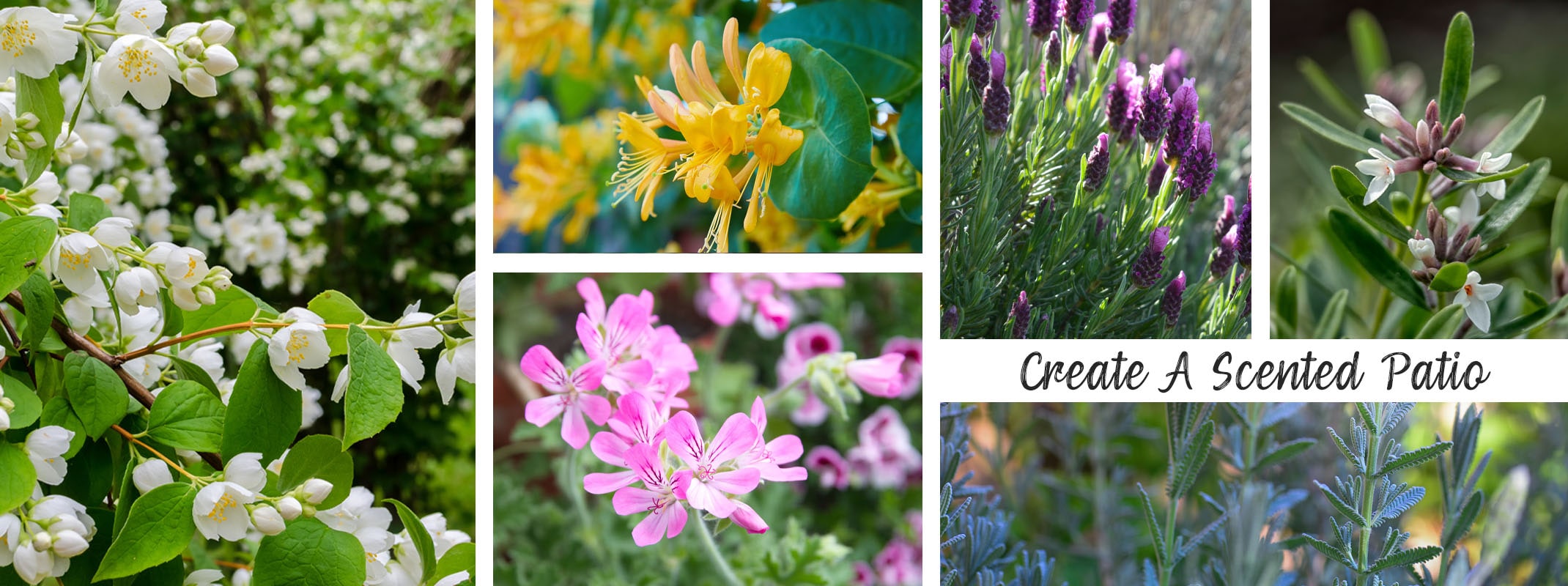
Whether you are looking for a hint of fragrance or a combination of beautiful scents, at SummerWinds Nursery, we have a wonderful selection of perennials, shrubs, and vines to help you create the scented patio you’re sure to love! (Please note that not all varieties may be available at all locations)
We’ve expanded our selection!
Scented Flowers
Vines Shrubs PerennialsScented Leaves
Scented Flowers
Scented Flowering Vines
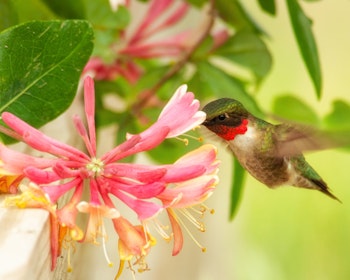 Honeysuckle Vine Lonicera
Honeysuckle Vine Lonicera
Lonicera, commonly known as Honeysuckle, thrives in the Bay Area of California. These vining plants are prized for their fragrant, tubular flowers that attract hummingbirds and butterflies. They prefer full to partial sun and well-drained soil. With their vigorous growth and twining habit, they are ideal for trellises, fences, or as ground cover. Some varieties are evergreen, providing year-round foliage. Their adaptability and ability to tolerate coastal conditions make them a delightful addition to any garden in the Bay Area.
Star Jasmine
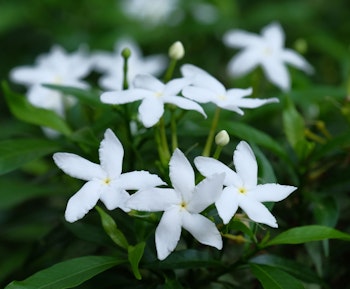
Trachelospermum jasminoides, commonly known as Star Jasmine, is a beautiful and popular flowering vine that is well-suited for the Bay Area of California. This evergreen vine has glossy, dark green leaves that can climb or sprawl depending on the support it’s given. It produces clusters of small, fragrant, white, star-shaped flowers in spring and summer, which emit a sweet, jasmine-like scent.
- Light - Thrives in full sun to light shade. In the Bay Area, it generally prefers a location with morning sun and afternoon shade to protect it from intense heat during the hottest part of the day.
- Soils - Prefers well-draining soil with a slightly acidic to neutral pH. Bay Area soils can vary, but adding organic matter can improve soil structure and drainage.
- Pruning - Prune the plant after flowering to maintain its shape and control its growth. This will also encourage more flower production for the following season.
- Uses – Star Jasmine is often used for covering fences, walls, and pergolas, providing a beautiful green backdrop with its glossy foliage and fragrant blooms. It can also be grown in containers and used as a ground cover.
Scented Flowering Shrubs
Daphne
Perfume Princess Daphne
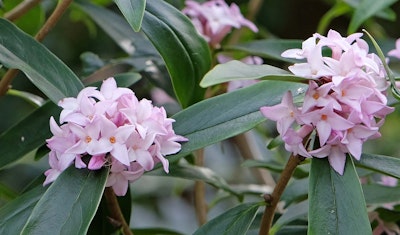
Daphne odora 'Perfume Princess' or Perfume Princess Daphne is an evergreen shrub known for its incredibly fragrant flowers. It features glossy, dark green leaves and produces clusters of white, pink-tinged flowers in late winter to early spring. The sweet and intoxicating fragrance of the blooms makes it a favorite among gardeners.
- Light - Perfume Princess Daphne prefers partial shade to dappled sunlight. Avoid planting it in full sun, as it can lead to leaf scorching.
- Soil - It thrives in well-draining, humus-rich, and slightly acidic soil.
- Watering - Provide regular and consistent watering to keep the soil evenly moist, but avoid overwatering, as it can be sensitive to root rot.
Eternal Fragrance Daphne
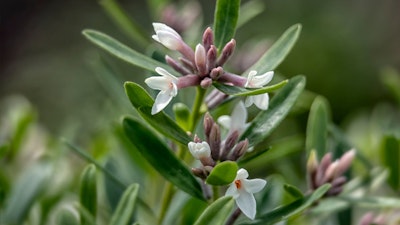
Daphne x transatlantica 'Eternal Fragrance' or Eternal Fragrance Daphne, this hybrid evergreen shrub is known for its abundant and long-lasting bloom periods. It features dark green leaves and produces clusters of pink, star-shaped flowers with a pleasant fragrance. The name "Eternal Fragrance" comes from the fact that it often blooms from spring through fall.
- Light - Eternal Fragrance Daphne does best in partial shade with some morning sun exposure. It appreciates protection from the hot afternoon sun.
- Soil - It prefers well-draining soil with good fertility and slightly acidic to neutral pH.
- Watering - Keep the soil consistently moist but not waterlogged. Regular watering is essential, especially during hot and dry periods.
Gardenias
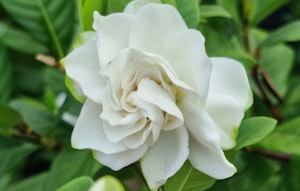 Veitchii Gardenia
Veitchii Gardenia
Gardenia jasminoides 'Veitchii' or Veitchii Gardenia is a beautiful evergreen shrub with dark green, glossy leaves and fragrant, double white flowers. The flowers have an intense sweet scent, adding a delightful fragrance to the garden. This variety is a bit more cold-tolerant than some other Gardenia cultivars.
- Light - It prefers partial shade to filtered sunlight. Morning sun with afternoon shade is ideal for this plant to protect it from the intense heat.
- Soil - Veitchii Gardenia thrives in well-draining, rich, and slightly acidic soil.
- Watering - Keep the soil consistently moist, especially during hot weather. However, avoid overwatering to prevent root rot.
- Size - This Gardenia can grow up to 4 to 6 feet in height and width, making it a medium-sized shrub.
First Love Gardenia
Gardenia jasminoides 'First Love' or First Love Gardenia is an evergreen shrub with large, waxy, double flowers that are pure white and emit a strong, sweet fragrance. It is known for its early blooming season and can produce flowers from late spring to summer.
- Light - It prefers partial shade to filtered sunlight, especially during the hottest part of the day.
- Soil - First Love Gardenia grows well in well-draining, acidic soil that is rich in organic matter.
- Watering - Keep the soil consistently moist, but avoid waterlogging. Regular watering is important, especially during dry periods.
- Size - This variety can reach a height and width of 3 to 4 feet.
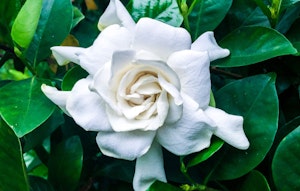 Gardenia Radicans
Gardenia Radicans
Gardenia jasminoides 'Radicans' or Gardenia Radicans is a dwarf variety of Gardenia, making it perfect for smaller spaces or as a ground cover. It has small, single, white flowers with a strong fragrance similar to other Gardenia varieties.
- Light - It prefers partial shade, but it can tolerate more sunlight than some other Gardenia varieties.
- Soil - Gardenia Radicans grows well in well-draining, slightly acidic soil.
- Watering - Keep the soil consistently moist but not soggy. Regular watering is essential, especially during dry spells.
- Size - This compact variety typically grows up to 1 to 2 feet in height and spread.
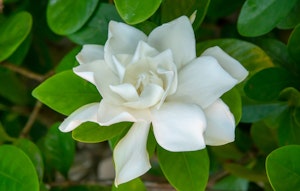 Gardenia August Beauty
Gardenia August Beauty
Gardenia jasminoides 'August Beauty' or August Beauty Gardenia is a popular variety known for its large, double, creamy-white flowers and strong fragrance. It is an evergreen shrub that blooms from late spring to early fall, providing beauty and fragrance for an extended period.
- Light - It prefers partial shade to filtered sunlight, especially during the hottest part of the day.
- Soil - August Beauty Gardenia thrives in well-draining, acidic soil with good organic content.
- Watering - Keep the soil consistently moist, but avoid waterlogging. Regular watering is crucial, especially in warmer weather.
- Size - This variety can grow to a height and width of 3 to 5 feet.
 Summer Soul® Arabian Jasmine from Monrovia
Summer Soul® Arabian Jasmine from Monrovia
Jasminum sambac 'Monhariklia,' commonly known as Arabian Jasmine shows off with beautiful white flowers and intensely sweet fragrance. This tropical shrub features large, highly scented, fully double flowers that fill the garden with fragrance. Its compact form and glossy evergreen foliage make it an attractive option for creating a clipped hedge in mild climates, where it can bloom almost year-round.
- Light - This plant prefers full sun to partial shade. In the Bay Area, it does well with morning sun and afternoon shade to protect it from intense heat during the hottest part of the day.
- Soil - Arabian Jasmine prefers well-draining soil with good fertility. It can adapt to different soil types but thrives best in loamy, rich soils.
- Pruning - Prune 'Monhariklia' after its flowering period to maintain its shape and encourage bushiness. Removing spent flowers can also promote more blooms.
- Uses - Jasminum sambac 'Monhariklia' is often grown as a fragrant shrub in gardens and can be used as a container plant for patios and balconies. Its flowers are popular for making leis and are also commonly used in floral arrangements and perfumery.
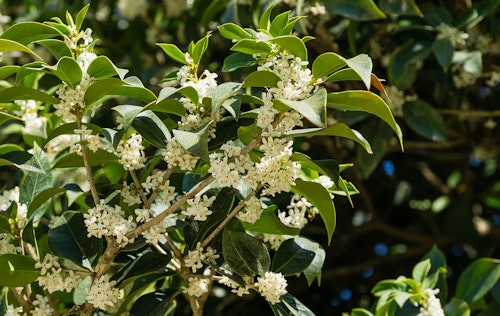 Sweet Osmanthus
Sweet Osmanthus
Sweet Osmanthus (Osmanthus fragrans) or Fragrant Olive is a medium-sized evergreen shrub or small tree with dense, oval-shaped, and glossy dark green leaves. It’s known for its highly fragrant flowers that emit a sweet, apricot-like scent, especially noticeable in the fall. Sweet Osmanthus offers small, star-shaped flowers, usually white or creamy-yellow in color, and arranged in clusters.
- Bloom - Typically blooms in the autumn season, though some varieties may bloom in the spring.
- Size - Can reach a height of 10 to 30 feet and a similar spread, depending on the variety and growing conditions.
- Location - Prefers well-drained soil and a sunny to partially shaded location.
- Uses - Often used as an ornamental plant in gardens and landscapes due to its beautiful fragrance and attractive appearance. The flowers are used in the production of perfumes, teas, and other scented products.
Plumerias
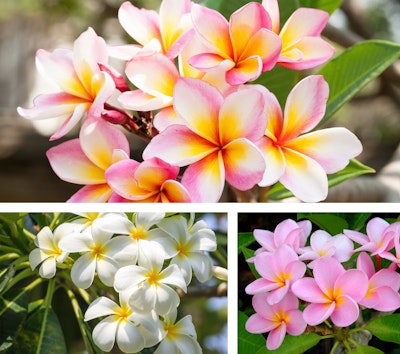
Deciduous small to medium-sized shrubs with thick, succulent branches and a milky sap with highly fragrant, five-petaled flowers with a wide range of colors, including white, yellow, pink, red, and multiple color combinations. Plumerias bloom during the warmer months, especially in summer and early autumn and offer a lovely, sweet, exotic fragrance, which varies slightly among different Plumeria species and cultivars.
- Growth - Moderate to fast-growing.
- Size - Depending on the species and growing conditions, plumeria trees can range from 6 to 25 feet in height.
- Requires full sun and well-draining soil to thrive.
- Uses - Plumeria is widely used as an ornamental plant in tropical and subtropical gardens and is also a popular choice for lei-making in Hawaii and other Pacific islands due to its fragrant flowers.
Roses
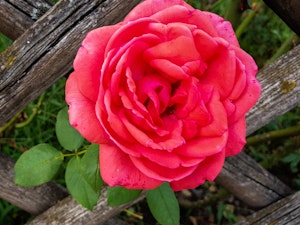 Assorted collection of scented roses
Assorted collection of scented roses
Choose from roses that offer a sweet fragrance, spicy or clove-like to enhance your garden. Beautiful, well-shaped blooms on a robust plant with dark glossy leaves.
- Light – Full Sun
- Watering – Water when top 2 inches of soil is dry
Scented Flowering Perennials
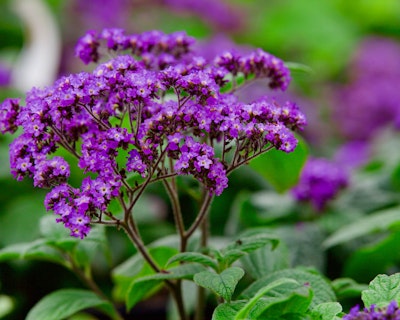 Heliotrope
Heliotrope
Heliotrope (Heliotropium arborescens) is a lovely and fragrant flowering plant that performs well in the Bay Area of California. It’s a bushy, herbaceous perennial with attractive dark green, velvety leaves. Known for its clusters of small, intensely fragrant flowers, Heliotrope range in color from deep purple to lavender or white. The flowers have a sweet vanilla-like scent that is particularly enchanting, making it a popular choice for gardens and containers.
- Light - Heliotrope prefers full sun to partial shade. It thrives in locations with at least 4-6 hours of direct sunlight per day.
- Soil - It does best in well-draining soil that is fertile and rich in organic matter. A slightly acidic to neutral pH is preferred.
- Size - Heliotrope can grow to a height of about 1 to 3 feet and has a similar spread.
- Uses - Heliotrope is commonly used for its delightful fragrance and beautiful flowers in gardens, borders, and containers. It can also be grown indoors as a houseplant if provided with sufficient light.
Care: Heliotrope is relatively low-maintenance but benefits from regular deadheading to encourage continuous flowering. Pruning can help maintain a compact shape and promote new growth. Feeding with a balanced fertilizer during the growing season enhances its performance.
Scented Leaves
Scented Geraniums
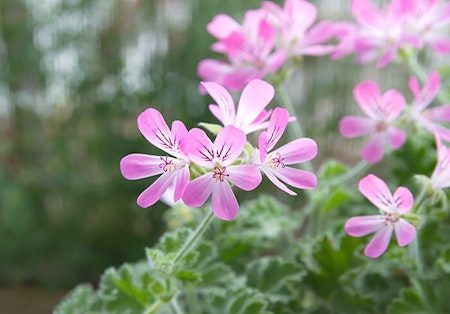
Scented Geraniums (Pelargonium spp.) are a diverse group of plants that thrive in the Bay Area of California. While they are not true geraniums (which belong to the genus Geranium), they are commonly known by this name due to their resemblance. They are herbaceous perennials that are prized for their aromatic leaves. The leaves come in various shapes, sizes, and textures, and each variety has a unique scent. Some common scents include rose, lemon, mint, apple, and citrus. The small, delicate flowers of Scented Geraniums are typically less showy than those of traditional geraniums.
- Light - Scented Geraniums prefer full to partial sun. In the Bay Area, they do well with morning sun and afternoon shade, especially during hot summer months.
- Soil: They thrive in well-draining soil with good fertility. Adding organic matter to the soil can help improve its structure and moisture retention.
- Watering - Keep the soil evenly moist, but avoid overwatering, as these plants are susceptible to root rot. Watering when the top inch of soil becomes dry is generally sufficient.
- Size: Scented Geraniums can range in size from small compact varieties that stay under a foot in height to larger ones that can reach up to 3 feet.
- Uses - Scented Geraniums are prized for their delightful fragrance and are commonly grown in containers, hanging baskets, or garden beds. They are also used in aromatherapy and culinary applications, where their leaves are infused into teas, desserts, and potpourri.
Care: Scented Geraniums are relatively easy to care for. Regular deadheading (removal of spent flowers) encourages continuous blooming. Pruning helps maintain their shape and bushiness. These plants generally benefit from regular feeding with a balanced fertilizer during the growing season.
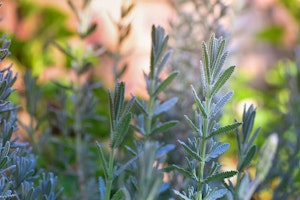 Rosemary
Rosemary
Rosemary (Rosmarinus officinalis) is an evergreen shrub with needle-like, aromatic leaves and small blue flowers. It has a pleasant, pine-like fragrance and is commonly used in culinary dishes and as a fragrant ornamental plant in gardens.
- Light - Rosemary thrives in full sun, requiring at least 6-8 hours of direct sunlight per day.
- Soil - It prefers well-draining, sandy or loamy soil with good fertility. Avoid heavy, clayey soils.
- Watering - Rosemary is drought-tolerant and prefers slightly dry conditions. Water it sparingly, allowing the soil to dry out between waterings.
- Size - Rosemary can grow to a height and width of 2 to 6 feet.
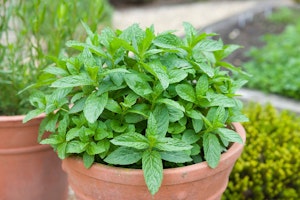 Mint
Mint
Mint (Mentha spp.) is a fast-growing herb with square stems and aromatic leaves. It comes in various varieties such as spearmint and peppermint, each with its distinct flavor and scent.
- Light - Mint thrives in partial to full sun but can tolerate some shade.
- Soil: It prefers moist, well-draining soil with good fertility. Mint can be quite invasive, so consider growing it in containers to control its spread.
- Watering - Keep the soil consistently moist. Mint enjoys regular watering, especially during hot weather.
- Size - Mint can grow to a height of 1 to 3 feet or more, depending on the variety.
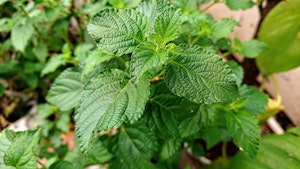 Yerba Buena
Yerba Buena
Yerba Buena (Satureja douglasii) , also known as Lemon Balm or Balm Mint, is a native perennial herb in California with glossy, dark green leaves and small white to pale pink flowers. It has a minty fragrance and is often used in traditional Native American cuisine and herbal medicine.
- Light - Yerba Buena does well in partial to full shade.
- Soil - It prefers moist, well-draining soil and can tolerate a range of soil types, including clay.
- Watering - Keep the soil consistently moist, especially during dry periods.
- Size - Yerba Buena typically grows to a height of 6 to 12 inches/
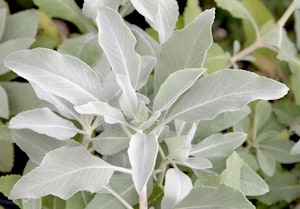 White Sage
White Sage
White Sage (Salvia apiana) is an aromatic evergreen shrub with silvery-gray leaves and tall spikes of white flowers. It is sacred to Native American cultures and is often used in smudging ceremonies for its purifying properties.
- Light - White Sage thrives in full sun and can tolerate hot, dry conditions.
- Soil - It prefers well-draining, sandy or rocky soil with low fertility.
- Watering - White Sage is drought-tolerant and should be watered sparingly, especially once established.
- Size - White Sage can grow to a height and width of 3 to 5 feet.
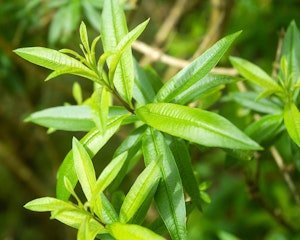 Lemon Verbena
Lemon Verbena
Lemon Verbena (Aloysia citrodora) is a deciduous shrub with lemon-scented, lance-shaped leaves. It produces tiny white or pale purple flowers and is prized for its strong lemon fragrance.
- Light - Lemon Verbena thrives in full sun to partial shade.
- Soil - It prefers well-draining, fertile soil with good organic content.
- Watering - Keep the soil consistently moist, but avoid waterlogged conditions.
- Size - Lemon Verbena can grow to a height of 3 to 6 feet.
Lavender
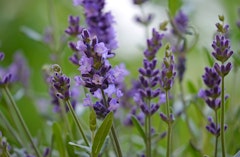
Lavandula angustifolia (Common Lavender)
Common Lavender is a compact, aromatic perennial herb with slender, gray-green foliage and spikes of fragrant, purple-blue flowers. It is well-loved for its calming scent and is often used in gardens, as a border plant, or in containers.
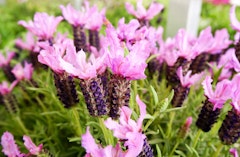
Lavandula stoechas (Winter Bee Spanish Lavender)
Winter Bee Spanish Lavender is a showy evergreen shrub with dense, gray-green foliage and distinct flowers featuring colorful bracts (modified leaves) at the top of the spikes. The bracts may be purple, pink, or white, depending on the cultivar.
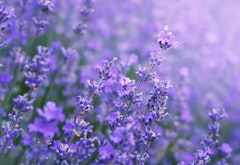
Lavandula angustifolia 'Hidcote'
Hidcote Lavender is a compact variety of English Lavender with deep purple flowers and silvery-gray foliage. It's a popular choice for borders, edging, or creating low hedges in the garden.
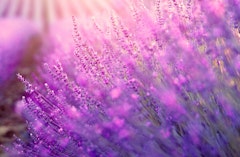
Lavandula x intermedia 'Provence'
Provence Lavender is a hybrid lavender that combines the best qualities of English and Spike Lavenders. It has long, slender flower spikes with pale purple blooms and a strong, pleasant fragrance. It's often used in culinary applications, crafts, and potpourri.
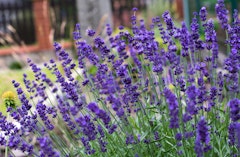
Lavandula x intermedia 'Hidcote Giant'
Hidcote Giant Lavender is a robust hybrid lavender with tall flower spikes and dark purple-blue flowers. It shares similarities with 'Provence' but may have more intense coloration and larger blooms.
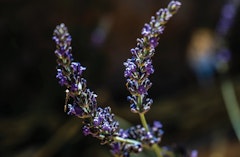
Lavandula x intermedia 'Phenomenal'
Phenomenal Lavender is a hardy and vigorous hybrid lavender with silvery foliage and violet-blue flowers. It's known for its exceptional tolerance to heat and humidity, making it a great choice for the Bay Area's climate.
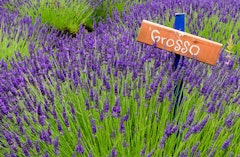
Lavandula x intermedia 'Grosso'
Grosso Lavender is another popular hybrid variety with long, dense flower spikes and deep purple-blue flowers. It's valued for its strong fragrance and is often used for dried flower arrangements and essential oil production.
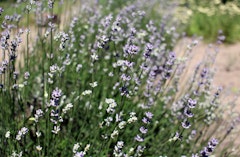
Lavandula angustifolia 'Munstead'
Munstead Lavender is a compact and bushy variety of English Lavender. It features aromatic, gray-green foliage and lavender-blue flowers. It's a classic choice for herb gardens and landscaping.

